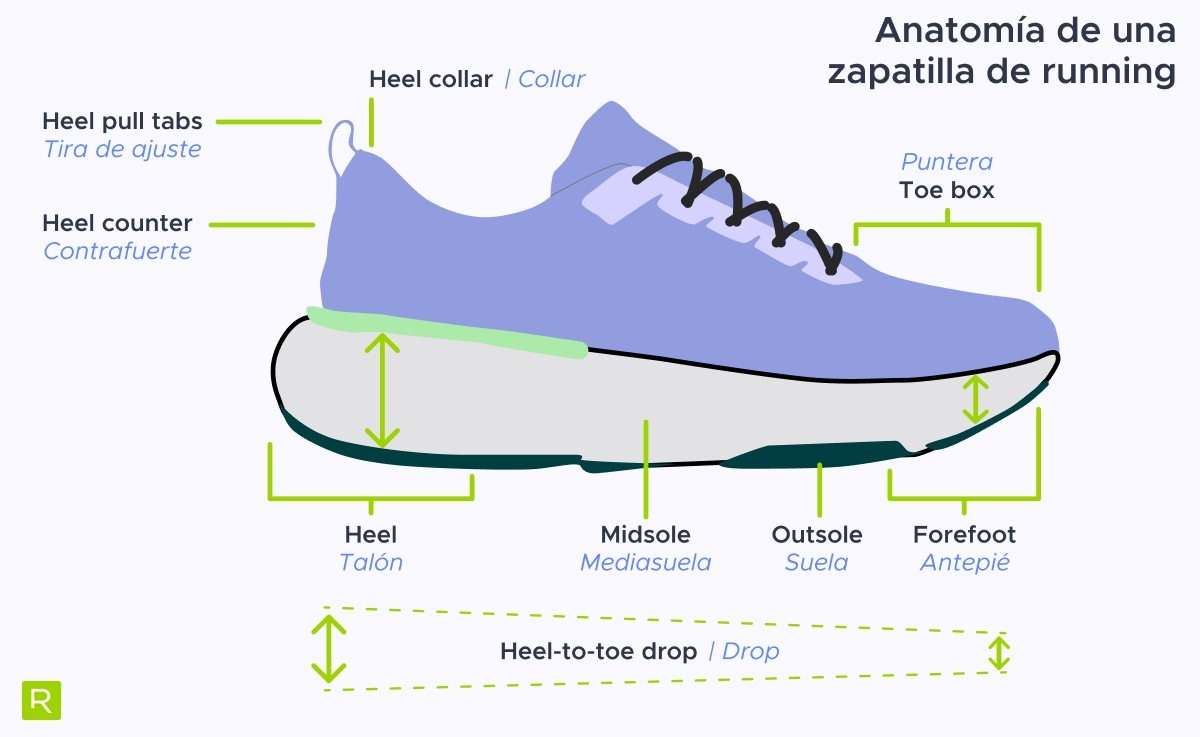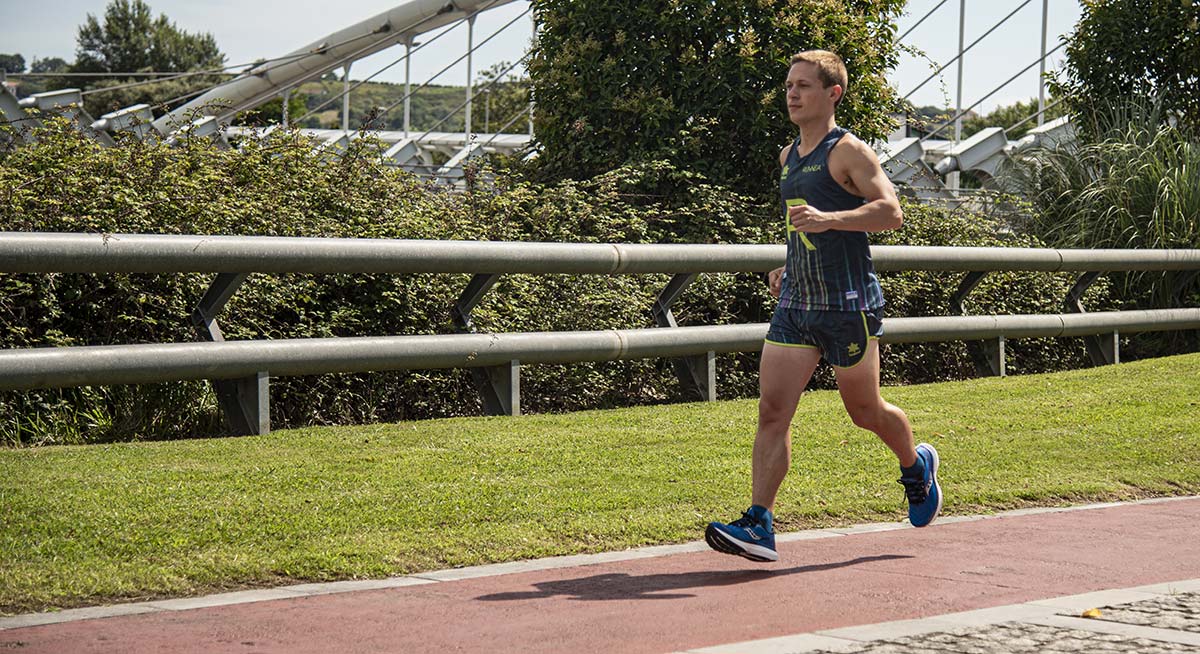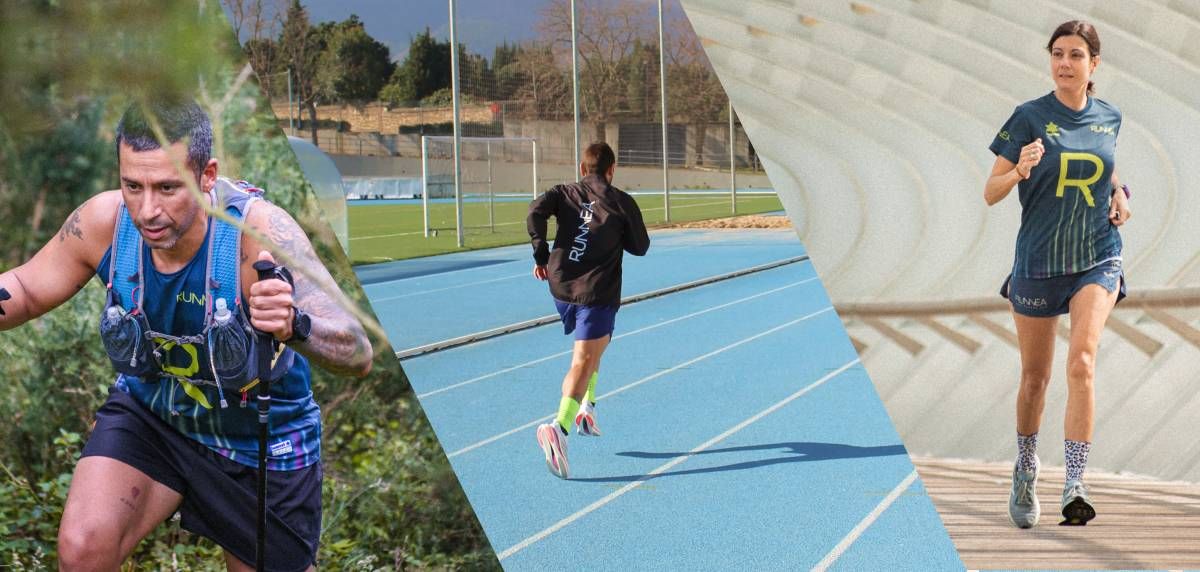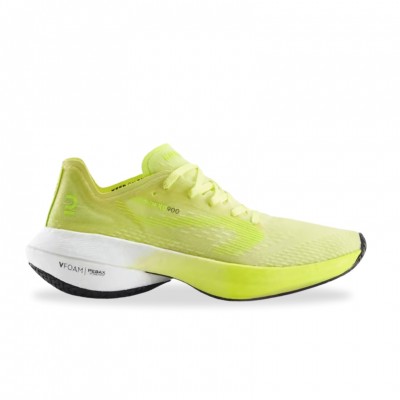Finding running shoes that fit your feet perfectly is not an easy task. In fact it is usually the first question that arises when we decide to start running or when we are going to face a challenge: marathon, trail, 10k... The current market offers such a large number of models that, at times, it can overwhelm you. However, it is worth spending some time to be properly informed and to compare the different models, because your running shoes play a key role in absorbing and reducing the vibrations that occur when your feet come into contact with the ground in each stride, so we present the guide to choose the right running shoes.
Not sure which running shoe to choose?
In a few simple steps we help you to choose the ideal running shoe for you
Go to the Shoe FinderAnatomy of a running shoe

Therefore, if you choose the wrong running shoe, you will have to face a lot of adverse effects that are not recommended. In this post we offer some basic tips for you to have some basic notions when you go to choose your next running shoes and, thus, your purchase is as satisfactory as possible.

At RUNNEA, in addition to having the most complete running shoes recommender, we want to help you so that your choice is not only based on the price or the aesthetics of the model. We want you to choose the shoe that best suits your running style and your physical characteristics. You already know that we offer a free advice service on the choice of your ideal shoe. First of all, it is important that you know what it means to be pronator, neutral or supinator?
1. Know your stride type:
- Pronator: If your foot tends to tilt inward when running, you need shoes with arch support and stability.
- Supinator: If your foot tends to roll outward, look for shoes with more cushioning and flexibility.
- Neutral: If your stride is neutral, you can opt for shoes with a balance between cushioning and support.
What is pronation and how does it affect the choice of shoe?
Pronation is the inward rotation of the foot when it comes into contact with the ground by running or walking. It is part of the natural motion and helps support the impact of each stride. Depending on the individual, the rotation of the foot may be less and is referred to as supination or more, also known as excessive pronation.
Having a pronated stride is neither good nor bad, but it does affect the way you run and can lead to injury. Because of this, running shoes have different designs that consider the different types of pronation. Depending on the type of pronation you have, you should choose a certain type of running shoes.
Neutral stride
Look at your shoes. If the outside of the soles have an S-shaped wear pattern from heel to toe, or in other words if you have an even stride, it is quite likely that you have a neutral pronation or neutral stride. If so, I congratulate you because you have a wide range of running shoes.
Supinator gait
When the rotation of the foot is excessive outward we would be talking about supination. Your weight is supported on the side of the shoe at the moment of foot strike, affecting the efficiency of the foot strike. The impact of the foot against the ground causes a greater vibration that affects the upper part of your legs. Supinator runners are more prone to injuries and fractures due to the impact of their stride. If this is your case, choose a shoe with good cushioning.
Similarly, it should also be noted that there are no models for supinator footprint as such, and the most widespread option is to get neutral shoes, to which you can incorporate an insole that allows you to run more comfortably.
Pronator footprint
When the rotation of the foot is excessive inwards, we are talking about pronation. In this case, the weight of your body tends to transfer to the inside of the foot, causing contact between the ground and the inside of the shoe, instead of the metatarsals. This results in an imbalance, causing the foot to rotate inward to regain some of the lost stability.
The shoes of a runner who suffers from excessive pronation will have a worn out inner heel and big toe area. The most recommended type of shoe is one with good cushioning and support.
2. Cushioning and Support:
- Cushioning: Fundamental for absorbing shock, especially if you run on hard surfaces such as asphalt. The amount of cushioning depends on your personal preference and type of running.
- Support: Especially important for runners with pronation or specific arch support needs.
3. Consider Terrain:
- Asphalt: it requires shoes with good cushioning and durability. Look for shoes for asphalt
- Trail: Look for shoes with a durable outsole, good traction and extra protection. Find trail running shoes
- Track: Lighter, more responsive shoes are ideal. Look for trail/trail running shoes
4. Experience and Distance:
- Beginners: May benefit from more cushioning to protect joints.
- Experienced runners: May prefer lighter shoes with less cushioning for a better feel for the terrain.
- Longer distances: Look for shoes with a combination of comfort, cushioning and durability.
5. Fit and Comfort:
- Sizing and fit: Make sure the shoes fit snugly, but with plenty of room in the toe box. We recommend taking a half size up from your dress shoe size.
- Try several options: Each brand has a slightly different fit, so try several to find the best fit for you. See our sizing guide
6. Durability and quality:
- Materials: Consider the quality of the materials, which will affect the durability and performance of the shoe.
- Review analysis: Read opinions and reviews to understand other runners' experience with the shoes. At RUNNEA you already know that you can leave us your opinion about any model of running shoe or trail running shoe.
7. Budget:
- Price-Performance: Not always the most expensive shoes are the best for you. Find a balance between quality, need and price.
8. Innovations and technology:
- Latest trends: stay informed about the latest innovations in running shoes, which can offer improvements in performance and comfort.
8 tips for buying running shoes
- Nowadays you can buy any running shoe from highly specialized online stores. Many offer free return shipping. You can buy two or three pairs, keep the ones that best suit your feet and return the others free of charge.
- If you prefer to buy running shoe in a physical store avoid, as far as possible, to go during the weekend. The crowds make customer service poorer during those busy days.
- If you have the opportunity, go to a specialized store where they do a biomechanical study of your footprint. If this is not your case and you do not know what type of footprint you have, I recommend you buy neutral shoes and then go to a podiatrist to have an insole made for you.
- When you go to buy running shoes, do it at the end of the day. Several studies have concluded that our feet can expand from a few millimeters to 2 centimeters by the end of the day.
- As you run, your feet swell. Keep this in mind. When you go to buy a new pair of shoes, make sure you leave a space of one toe width between your big toe and the toe of the shoe.
- Check with the manufacturer's website to find out how long the lifespan of the shoe you have just bought is and don't exceed it too much, as you will be putting your health at risk. A training shoe from a leading brand lasts on average about 700 kilometers.
- Try on running shoes with a compression sock or stocking model that you will wear when you go running.
- Never try on a new shoe on race day. Beforehand, try to go out and train in them for several days, so that they get used to your feet.
Read more news about: Running Training



























